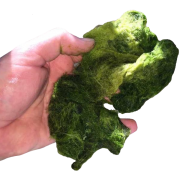Choosing a scrubber size
Probably the most frequently asked questions is “what size scrubber do I need for my system?” This is sometimes an easy answer, but in many cases the answer is “it depends”.
My scrubbers are sized primarily according to the level of feeding. If you go here http://algaescrubber.zohosites.com/planning-your-algae-scrubber.html and scroll about 1/2 way down, you will see a more in-depth description of “cube” and some other equivalent amounts for various types of foods that can help you estimate your total feeding level.
I would really love to see the entire filtration industry switch over to this sizing methodology that has been generally adopted by Algae Scrubber folks…but yeah, probably not going to happen!!
I do have a more in-depth methodology that is roughed out in my head regarding this question – because it is a common one. One of the issues though is that my “formula” tends to work well for my scrubbers, but it doesn’t necessarily translate to a DIY scrubber, which is why I haven’t developed it into something for general use quite yet.
Based on experience and feedback, here are some rough “dividing lines”
L2: good for tanks up to 120 to 150 gallons that are fed ~2 cubes/day, possibly a bit more feeding.
L4: good for tanks up to 250-300 gallons fed ~4 cubes/day
L8: tanks up to about 500g fed ~8 cubes/day
L16: up to 1000g systems fed ~16 cubes/day
Now given that, there are some adjustment factors that you can take into account.
The first is other filtration. If you have other “primary” filtration components, these are obviously going to take up some of the filtration load. These can be live rock, skimmer, biopellets or other carbon dosing, filter socks, auto-water-change systems, denitrators, phosphate reactors/GFO, carbon, macro refugiums, you name it.
So for example, if you have a 200g tank with a big skimmer (200-250g rated) and a biopellet reactor and you feed 4 cubes/day, you might be able to use an L2 because that skimmer and reactor are going to take up a good chunk of the load. But, you could also get an L4 and then the scrubber might take on a more complementary or possibly primary role, or give you room to grow, or serve as a fail-safe system.
Now let’s say you have a moderate sized skimmer (100-150g rated) and no BP reactor, now you likely to need the L4 as the scrubber is going to act more like primary filtration with the skimmer being complementary to the scrubber (but there are some really good 150g rated skimmers also…)
Another factor is tank turnover rate – this is probably only an issue when you are in the range of 100-300g. If you look at the total flow across the screen in GPH and then divide that by the system volume, you get a tank turnover rate (it’s not full-pass turnover, but anyways…). IMO you want this number to be > 1.0. So if an L2 need ~200 GPH and your tank is 200g, that’s a TTR=1 which is a bit low, but its’ OK. If you are at 250g, then it’s TTR=200/250=0.8, while an L4 at 400+ GPH would be TTR=400/250=1.6, much better. Once you get to the 300-400g range, that’s when the L4 TTR starts to close on 1.0, but when you jump to the L8 that doesn’t change because the unit length is the same, but the screen is 2x as tall so you get a longer contact time per pass.
Next you have other factors like persistent nutrient problems, a very neglected tank, or major algae problems. These tend to either bump you up a unit in size, but that is a temporary thing so I try to steer people who are in those situations to choose a unit that suits their “ideal” situation rather than view the scrubber as a “problem fixer”. A scrubber can be that, in the long term, but in the short term sometimes you just have to do what needs to be done to get on the path to that ideal situation then set yourself up for long term success.
Tanks that are larger than 300 gallons are typically expert-level systems, and are likely to have robust filtration systems. In systems like this, just about every filtration component is going to play a complementary role. There will likely not be a true “primary” method established, so the choice of scrubber size is typically more subjective.
While I hope this helps, I am always here to help you size a scrubber for your specific system!



